tow SKODA YETI 2011 1.G / 5L Workshop Manual
[x] Cancel search | Manufacturer: SKODA, Model Year: 2011, Model line: YETI, Model: SKODA YETI 2011 1.G / 5LPages: 252, PDF Size: 3.61 MB
Page 152 of 252
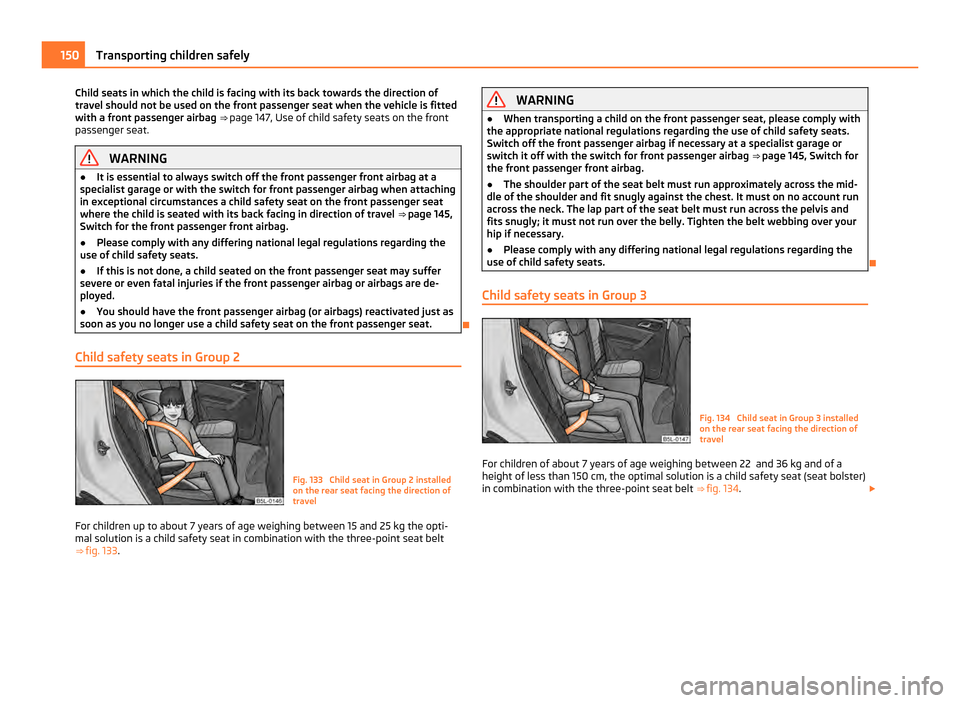
Child seats in which the child is facing with its back towards the direction of
travel should not be used on the front passenger seat when the vehicle is fitted
with a front passenger airbag
⇒
page 147, Use of child safety seats on the front
passenger seat. WARNING
● It is essential to always switch off the front passenger front airbag at a
specialist garage or with the switch for front passenger airbag when attaching
in exceptional circumstances a child safety seat on the front passenger seat
where the child is seated with its back facing in direction of travel ⇒
page 145,
Switch for the front passenger front airbag.
● Please comply with any differing national legal regulations regarding the
use of child safety seats.
● If this is not done, a child seated on the front passenger seat may suffer
severe or even fatal injuries if the front passenger airbag or airbags are de-
ployed.
● You should have the front passenger airbag (or airbags) reactivated just as
soon as you no longer use a child safety seat on the front passenger seat.
Child safety seats in Group 2 Fig. 133 Child seat in Group 2 installed
on the rear seat facing the direction of
travel
For children up to about 7 years of age weighing between 15 and 25 kg the opti-
mal solution is a child safety seat in combination with the three-point seat belt
⇒ fig. 133. WARNING
● When transporting a child on the front passenger seat, please comply with
the appropriate national regulations regarding the use of child safety seats.
Switch off the front passenger airbag if necessary at a specialist garage or
switch it off with the switch for front passenger airbag ⇒
page 145, Switch for
the front passenger front airbag.
● The shoulder part of the seat belt must run approximately across the mid-
dle of the shoulder and fit snugly against the chest. It must on no account run
across the neck. The lap part of the seat belt must run across the pelvis and
fits snugly; it must not run over the belly. Tighten the belt webbing over your
hip if necessary.
● Please comply with any differing national legal regulations regarding the
use of child safety seats.
Child safety seats in Group 3 Fig. 134 Child seat in Group 3 installed
on the rear seat facing the direction of
travel
For children of about 7 years of age weighing between 22 and 36 kg and of a
height of less than 150
cm, the optimal solution is a child safety seat (seat bolster)
in combination with the three-point seat belt ⇒ fig. 134 . £150
Transporting children safely
Page 157 of 252
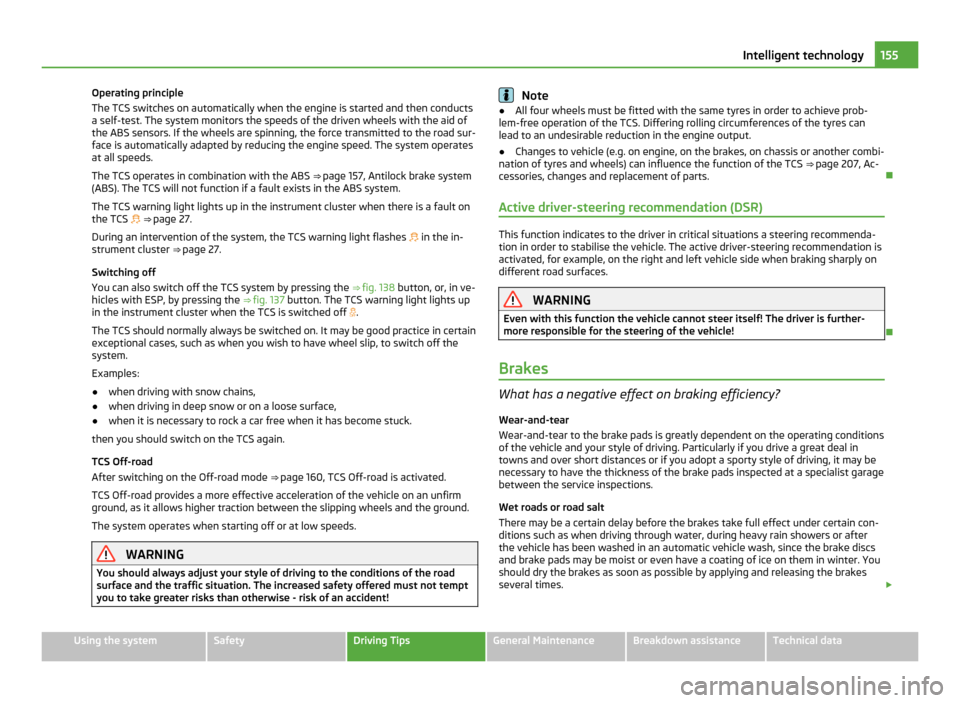
Operating principle
The TCS switches on automatically when the engine is started and then conducts
a self-test. The system monitors the speeds of the driven wheels with the aid of
the ABS sensors. If the wheels are spinning, the force transmitted to the road sur-
face is automatically adapted by reducing the engine speed. The system operates
at all speeds.
The TCS operates in combination with the ABS ⇒ page 157,
Antilock brake system
(ABS). The TCS will not function if a fault exists in the ABS system.
The TCS warning light lights up in the instrument cluster when there is a fault on
the TCS ⇒ page 27.
During an intervention of the system, the TCS warning light flashes in the in-
strument cluster ⇒ page 27.
Switching off
You can also switch off the TCS system by pressing the ⇒ fig. 138 button, or, in ve-
hicles with ESP, by pressing the ⇒ fig. 137 button. The TCS warning light lights up
in the instrument cluster when the TCS is switched off .
The TCS should normally always be switched on. It may be good practice in certain
exceptional cases, such as when you wish to have wheel slip, to switch off the
system.
Examples:
● when driving with snow chains,
● when driving in deep snow or on a loose surface,
● when it is necessary to rock a car free when it has become stuck.
then you should switch on the TCS again.
TCS Off-road
After switching on the Off-road mode ⇒ page 160
, TCS Off-road is activated.
TCS Off-road provides a more effective acceleration of the vehicle on an unfirm
ground, as it allows higher traction between the slipping wheels and the ground.
The system operates when starting off or at low speeds. WARNING
You should always adjust your style of driving to the conditions of the road
surface and the traffic situation. The increased safety offered must not tempt
you to take greater risks than otherwise - risk of an accident! Note
● All four wheels must be fitted with the same tyres in order to achieve prob-
lem-free operation of the TCS. Differing rolling circumferences of the tyres can
lead to an undesirable reduction in the engine output.
● Changes to vehicle (e.g. on engine, on the brakes, on chassis or another combi-
nation of tyres and wheels) can influence the function of the TCS ⇒
page 207, Ac-
cessories, changes and replacement of parts.
Active driver-steering recommendation (DSR) This function indicates to the driver in critical situations a steering recommenda-
tion in order to stabilise the vehicle. The active driver-steering recommendation is
activated, for example, on the right and left vehicle side when braking sharply on
different road surfaces. WARNING
Even with this function the vehicle cannot steer itself! The driver is further-
more responsible for the steering of the vehicle!
Brakes What has a negative effect on braking efficiency?
Wear-and-tear
Wear-and-tear to the brake pads is greatly dependent on the operating conditions
of the vehicle and your style of driving. Particularly if you drive a great deal in
towns and over short distances or if you adopt a sporty style of driving, it may be
necessary to have the thickness of the brake pads inspected at a specialist garage
between the service inspections.
Wet roads or road salt
There may be a certain delay before the brakes take full effect under certain con-
ditions such as when driving through water, during heavy rain showers or after
the vehicle has been washed in an automatic vehicle wash, since the brake discs
and brake pads may be moist or even have a coating of ice on them in winter. You
should dry the brakes as soon as possible by applying and releasing the brakes
several times. £ 155
Intelligent technology Using the system Safety Driving Tips General Maintenance Breakdown assistance Technical data
Page 160 of 252
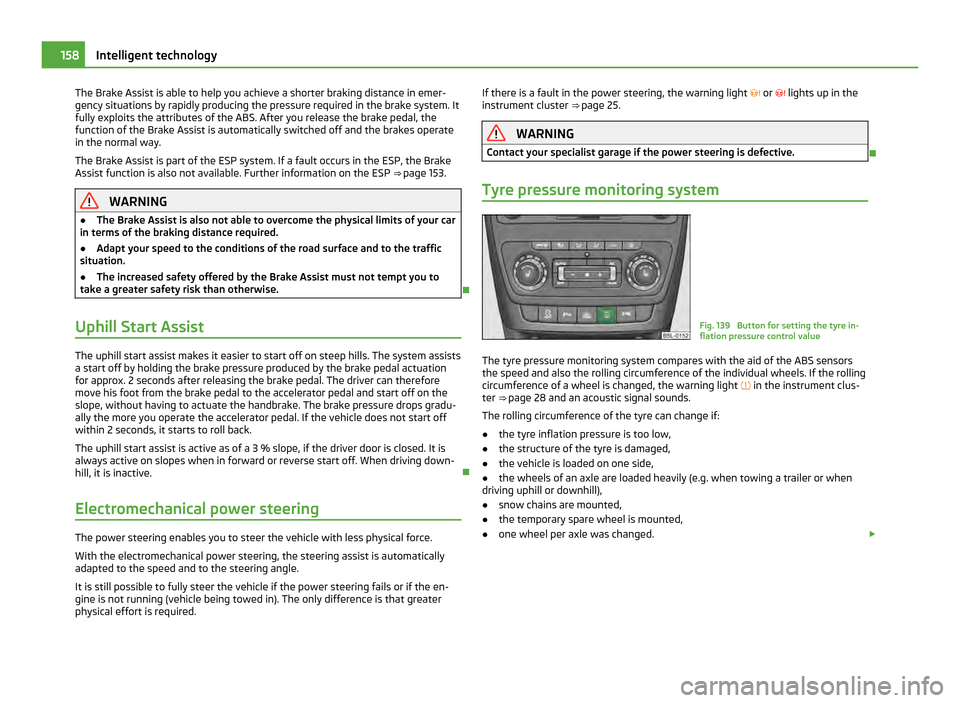
The Brake Assist is able to help you achieve a shorter braking distance in emer-
gency situations by rapidly producing the pressure required in the brake system. It
fully exploits the attributes of the ABS. After you release the brake pedal, the
function of the Brake Assist is automatically switched off and the brakes operate
in the normal way.
The Brake Assist is part of the ESP system. If a fault occurs in the ESP, the Brake
Assist function is also not available. Further information on the ESP
⇒ page 153.WARNING
● The Brake Assist is also not able to overcome the physical limits of your car
in terms of the braking distance required.
● Adapt your speed to the conditions of the road surface and to the traffic
situation.
● The increased safety offered by the Brake Assist must not tempt you to
take a greater safety risk than otherwise.
Uphill Start Assist The uphill start assist makes it easier to start off on steep hills. The system assists
a start off by holding the brake pressure produced by the brake pedal actuation
for approx. 2 seconds after releasing the brake pedal. The driver can therefore
move his foot from the brake pedal to the accelerator pedal and start off on the
slope, without having to actuate the handbrake. The brake pressure drops gradu-
ally the more you operate the accelerator pedal. If the vehicle does not start off
within 2 seconds, it starts to roll back.
The uphill start assist is active as of a 3 % slope, if the driver door is closed. It is
always active on slopes when in forward or reverse start off. When driving down-
hill, it is inactive.
Electromechanical power steering The power steering enables you to steer the vehicle with less physical force.
With the electromechanical power steering, the steering assist is automatically
adapted to the speed and to the steering angle.
It is still possible to fully steer the vehicle if the power steering fails or if the en-
gine is not running (vehicle being towed in). The only difference is that greater
physical effort is required. If there is a fault in the power steering, the warning light
or lights up in the
instrument cluster ⇒
page 25. WARNING
Contact your specialist garage if the power steering is defective.
Tyre pressure monitoring system Fig. 139 Button for setting the tyre in-
flation pressure control value
The tyre pressure monitoring system compares with the aid of the ABS sensors
the speed and also the rolling circumference of the individual wheels. If the rolling
circumference of a wheel is changed, the warning light
in the instrument clus-
ter ⇒ page 28 and an acoustic signal sounds.
The rolling circumference of the tyre can change if:
● the tyre inflation pressure is too low,
● the structure of the tyre is damaged,
● the vehicle is loaded on one side,
● the wheels of an axle are loaded heavily (e.g. when towing a trailer or when
driving uphill or downhill),
● snow chains are mounted,
● the temporary spare wheel is mounted,
● one wheel per axle was changed. £158
Intelligent technology
Page 164 of 252

Driving and the environment
The first 1 500 kilometres and then afterwards
New engine The engine has to be run in during the first 1 500 kilometres.
Up to 1 000 kilometres
– Do not drive faster than 3/4 of the maximum speed of the gear in use, that is
3/4 of the maximum permissible engine speed.
– Do not use full throttle.
– Avoid high engine revolutions.
– Do not tow a trailer.
From 1 000 up to 1 500 kilometres
– Increase the power output of the engine gradually up to the full speed of the
gear engaged, that is up to the maximum permissible engine revolutions.
During the first operating hours the engine has higher internal friction than later
until all of the moving parts have harmonized. The driving style which you adopt
during the first approx.1 500 kilometres plays a decisive part in the success of run-
ning in your car.
You should not drive at unnecessarily high engine revolutions even after the run-
ning-in period is complete. The maximum permissible engine speed is marked by
the beginning of the red zone on the scale of the revolutions counter. Shift up in-
to the next higher gear on a vehicle fitted with manual gearbox before the red
zone is reached. During acceleration (depressing the accelerator) exceptionally
high engine speeds are automatically reduced, yet the engine is not protected
against too high engine speeds which are caused by incorrectly shifting down the
gears resulting in a sudden increase of the engine speeds above the permitted
maximum revolutions which can lead to engine damage.
For a vehicle fitted with a manual gearbox the converse situation also applies: Do
not drive at engine revolutions which are too low. Shift down as soon as the en-
gine is no longer running smoothly. CAUTION
All the speed and engine revolution figures apply only when the engine is at its
normal operating temperature. Never rev up an engine which is cold, neither when
the vehicle is stationary nor when driving in individual gears. For the sake of the environment
Not driving at unnecessarily high engine revolutions and shifting to a higher gear
as early as possible are ways to minimise fuel consumption and operating noise
levels and protects the environment.
New tyres New tyres have to be “run in” since they do not offer optimal grip at first. You
should take account of this fact for the first 500 kilometres and drive particularly
carefully.
New brake pads Allow for the fact that new brake pads do not achieve their full braking efficiency
until approximately 200 kilometres. New brake pads must be first “run in” before
they develop their optimal friction force. You can, however, compensate for this
slightly reduced braking force by increasing the pressure on the brake pedal.
This guideline also applies to any new brake pads installed at a future date.
During the running-in period, you should avoid excessive stresses on the brakes.
This includes, for example, violent braking, particularly from very high speeds, and
also when crossing mountain passes.
Catalytic converter Proper operation of the emission control system (catalytic convert-
er) is of major significance for driving your vehicle in an environ-
mentally conscious way.
Please refer to the following guidelines: £162
Driving and the environment
Page 165 of 252

–
For vehicles with petrol engine only refuel with unleaded petrol ⇒ page 186,
Fuel.
– Never run the fuel tank completely empty.
– Do not switch off the ignition while you are driving the vehicle.
– Do not pour too much oil into the engine ⇒
page 192, Replenishing engine oil.
If you drive your vehicle in a country in which unleaded petrol is not available, you
must have the catalytic converter replaced later when driving the vehicle into a
country in which use of a catalytic converter is mandatory. WARNING
● In view of the high temperatures which may be produced in the catalytic
converter, one should always park a vehicle in such a way that the catalytic
converter cannot come into contact with easily flammable materials below the
vehicle - a risk of fire!
● Never use additional underbody protection or corrosion-protection agents
for the exhaust pipes, catalytic converters or heat shields. Such substances
might ignite when driving - risk of fire! CAUTION
● On vehicles fitted with a catalytic converter, never let the fuel tank run com-
pletely empty. An irregular fuel supply can result in poor ignition or misfiring. Un-
burnt fuel may get into the exhaust system and damage the catalytic converter.
● Filling the tank even only once with leaded petrol will result in the catalytic
converter being destroyed.
● If you detect misfiring, a drop in performance or irregular engine running when
driving, reduce your speed immediately and have the vehicle inspected by the
nearest specialist garage. The symptoms described may be caused by a fault in
the ignition system. Unburnt fuel may get into the exhaust system and damage
the catalytic converter. For the sake of the environment
Even if the exhaust system is operating properly, a sulphur-like exhaust odour
may be produced under certain operating conditions of the engine. This depends
on the sulphur content of the fuel. It is often sufficient to refuel with unleaded
premium-grade petrol of a different brand or at a different filling station. Driving in an economical and environmentally
conscious manner
General Your personal style of driving is a major factor.
Your fuel consumption, any pollution of the environmental and the wear-and-tear
to the engine, brakes and tyres, depend essentially on three factors:
● your personal style of driving,
● the conditions under which your vehicle is operated,
● technical aspects.
You can easily improve your fuel economy by 10 - 15 percent by driving in an eco-
nomical way with foresight. This section is intended to provide you with a number
of tips on how to protect the environment and at the same time save money.
The fuel consumption can naturally also be influenced by factors which are be-
yond the driver's control. It is, for example, normal for the fuel consumption to in-
crease in winter and under worsened conditions such as poor road conditions,
towing a trailer, etc.
The technical requirements for low fuel usage and economic efficiency of the ve-
hicle have already been built into the vehicle at the works. Special attention has
been given to minimising negative effects on the environment. It is necessary to
take note of the guidelines given in this chapter in order to make best use of
these characteristics and to maintain their effectiveness.
The optimal engine speed should be obtained when accelerating, in order to avoid
a high fuel consumption and resonance of the vehicle.
Looking ahead when driving A vehicle's highest fuel consumption occurs it accelerates.
Avoid accelerating and braking unnecessarily. If you drive with foresight you will
not need to brake so often and will also then not have to accelerate so much. Let
your vehicle coast to a stop, for example, if this is possible, when you see that the
next set of traffic lights is at red. 163
Driving and the environment Using the system Safety Driving Tips General Maintenance Breakdown assistance Technical data
Page 168 of 252
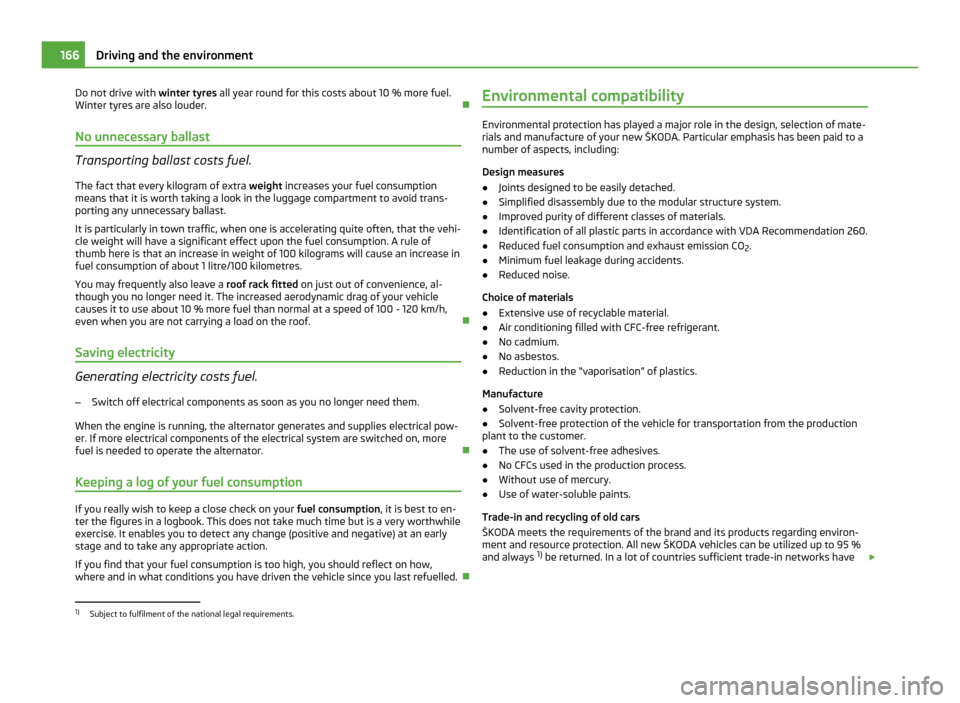
Do not drive with winter tyres all year round for this costs about 10 % more fuel.
Winter tyres are also louder.
No unnecessary ballast Transporting ballast costs fuel.
The fact that every kilogram of extra weight increases your fuel consumption
means that it is worth taking a look in the luggage compartment to avoid trans-
porting any unnecessary ballast.
It is particularly in town traffic, when one is accelerating quite often, that the vehi-
cle weight will have a significant effect upon the fuel consumption. A rule of
thumb here is that an increase in weight of 100 kilograms will cause an increase in
fuel consumption of about 1 litre/100 kilometres.
You may frequently also leave a roof rack fitted on just out of convenience, al-
though you no longer need it. The increased aerodynamic drag of your vehicle
causes it to use about 10 % more fuel than normal at a speed of 100 - 120 km/h,
even when you are not carrying a load on the roof.
Saving electricity Generating electricity costs fuel.
– Switch off electrical components as soon as you no longer need them.
When the engine is running, the alternator generates and supplies electrical pow-
er. If more electrical components of the electrical system are switched on, more
fuel is needed to operate the alternator.
Keeping a log of your fuel consumption If you really wish to keep a close check on your
fuel consumption, it is best to en-
ter the figures in a logbook. This does not take much time but is a very worthwhile
exercise. It enables you to detect any change (positive and negative) at an early
stage and to take any appropriate action.
If you find that your fuel consumption is too high, you should reflect on how,
where and in what conditions you have driven the vehicle since you last refuelled. Environmental compatibility Environmental protection has played a major role in the design, selection of mate-
rials and manufacture of your new ŠKODA. Particular emphasis has been paid to a
number of aspects, including:
Design measures
● Joints designed to be easily detached.
● Simplified disassembly due to the modular structure system.
● Improved purity of different classes of materials.
● Identification of all plastic parts in accordance with VDA Recommendation 260.
● Reduced fuel consumption and exhaust emission CO
2.
● Minimum fuel leakage during accidents.
● Reduced noise.
Choice of materials
● Extensive use of recyclable material.
● Air conditioning filled with CFC-free refrigerant.
● No cadmium.
● No asbestos.
● Reduction in the “vaporisation” of plastics.
Manufacture
● Solvent-free cavity protection.
● Solvent-free protection of the vehicle for transportation from the production
plant to the customer.
● The use of solvent-free adhesives.
● No CFCs used in the production process.
● Without use of mercury.
● Use of water-soluble paints.
Trade-in and recycling of old cars
ŠKODA meets the requirements of the brand and its products regarding environ-
ment and resource protection. All new
ŠKODA vehicles can be utilized up to 95 %
and always 1)
be returned. In a lot of countries sufficient trade-in networks have £1)
Subject to fulfilment of the national legal requirements. 166
Driving and the environment
Page 172 of 252
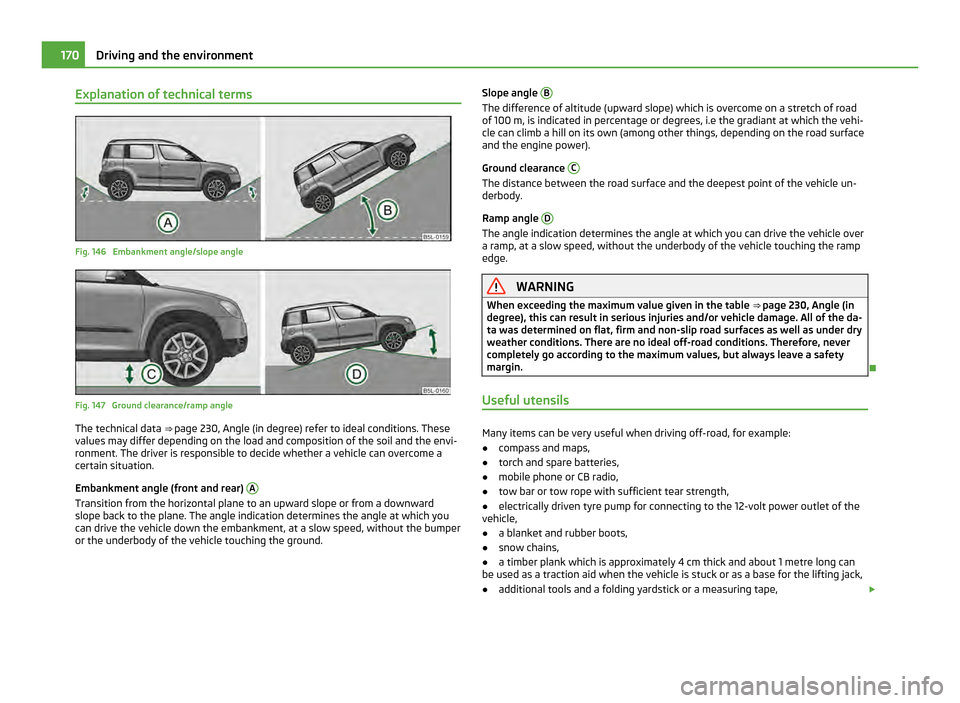
Explanation of technical terms
Fig. 146 Embankment angle/slope angle
Fig. 147 Ground clearance/ramp angle
The technical data
⇒
page 230, Angle (in degree) refer to ideal conditions. These
values may differ depending on the load and composition of the soil and the envi-
ronment. The driver is responsible to decide whether a vehicle can overcome a
certain situation.
Embankment angle (front and rear) ATransition from the horizontal plane to an upward slope or from a downward
slope back to the plane. The angle indication determines the angle at which you
can drive the vehicle down the embankment, at a slow speed, without the bumper
or the underbody of the vehicle touching the ground. Slope angle
B The difference of altitude (upward slope) which is overcome on a stretch of road
of 100 m, is indicated in percentage or degrees, i.e the gradiant at which the vehi-
cle can climb a hill on its own (among other things, depending on the road surface
and the engine power).
Ground clearance
C The distance between the road surface and the deepest point of the vehicle un-
derbody.
Ramp angle D The angle indication determines the angle at which you can drive the vehicle over
a ramp, at a slow speed, without the underbody of the vehicle touching the ramp
edge.
WARNING
When exceeding the maximum value given in the table ⇒
page 230, Angle (in
degree), this can result in serious injuries and/or vehicle damage. All of the da-
ta was determined on flat, firm and non-slip road surfaces as well as under dry
weather conditions. There are no ideal off-road conditions. Therefore, never
completely go according to the maximum values, but always leave a safety
margin.
Useful utensils Many items can be very useful when driving off-road, for example:
● compass and maps,
● torch and spare batteries,
● mobile phone or CB radio,
● tow bar or tow rope with sufficient tear strength,
● electrically driven tyre pump for connecting to the 12-volt power outlet of the
vehicle,
● a blanket and rubber boots,
● snow chains,
● a timber plank which is approximately 4 cm thick and about 1 metre long can
be used as a traction aid when the vehicle is stuck or as a base for the lifting jack,
● additional tools and a folding yardstick or a measuring tape, £170
Driving and the environment
Page 173 of 252
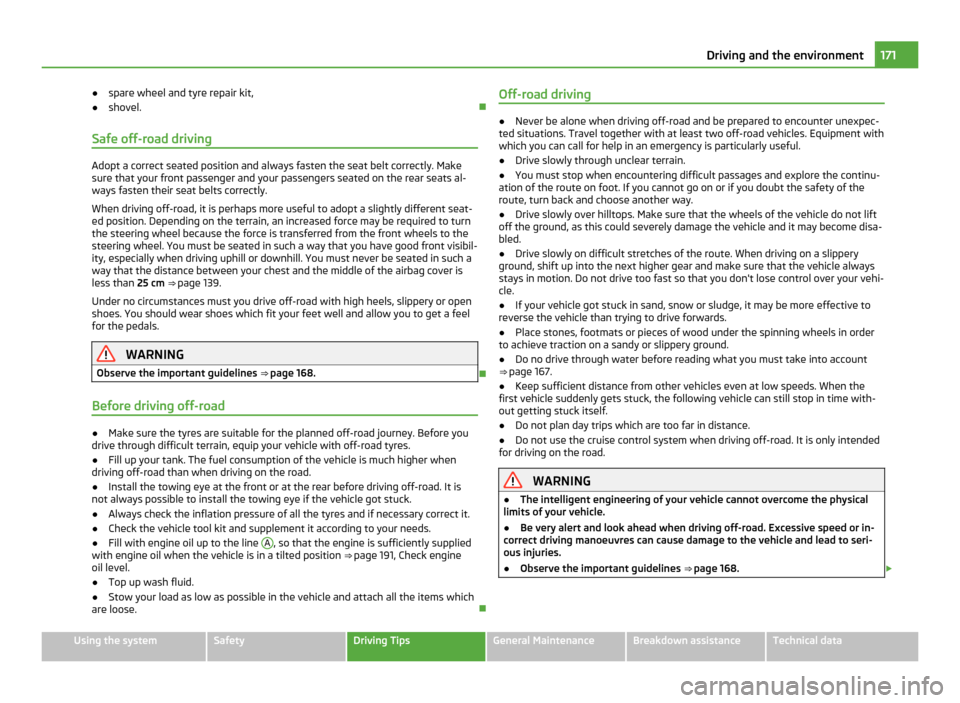
●
spare wheel and tyre repair kit,
● shovel.
Safe off-road driving Adopt a correct seated position and always fasten the seat belt correctly. Make
sure that your front passenger and your passengers seated on the rear seats al-
ways fasten their seat belts correctly.
When driving off-road, it is perhaps more useful to adopt a slightly different seat-
ed position. Depending on the terrain, an increased force may be required to turn
the steering wheel because the force is transferred from the front wheels to the
steering wheel. You must be seated in such a way that you have good front visibil-
ity, especially when driving uphill or downhill. You must never be seated in such a
way that the distance between your chest and the middle of the airbag cover is
less than 25 cm ⇒
page 139.
Under no circumstances must you drive off-road with high heels, slippery or open
shoes. You should wear shoes which fit your feet well and allow you to get a feel
for the pedals. WARNING
Observe the important guidelines ⇒
page 168.
Before driving off-road ●
Make sure the tyres are suitable for the planned off-road journey. Before you
drive through difficult terrain, equip your vehicle with off-road tyres.
● Fill up your tank. The fuel consumption of the vehicle is much higher when
driving off-road than when driving on the road.
● Install the towing eye at the front or at the rear before driving off-road. It is
not always possible to install the towing eye if the vehicle got stuck.
● Always check the inflation pressure of all the tyres and if necessary correct it.
● Check the vehicle tool kit and supplement it according to your needs.
● Fill with engine oil up to the line A , so that the engine is sufficiently supplied
with engine oil when the vehicle is in a tilted position ⇒
page 191, Check engine
oil level.
● Top up wash fluid.
● Stow your load as low as possible in the vehicle and attach all the items which
are loose. Off-road driving ●
Never be alone when driving off-road and be prepared to encounter unexpec-
ted situations. Travel together with at least two off-road vehicles. Equipment with
which you can call for help in an emergency is particularly useful.
● Drive slowly through unclear terrain.
● You must stop when encountering difficult passages and explore the continu-
ation of the route on foot. If you cannot go on or if you doubt the safety of the
route, turn back and choose another way.
● Drive slowly over hilltops. Make sure that the wheels of the vehicle do not lift
off the ground, as this could severely damage the vehicle and it may become disa-
bled.
● Drive slowly on difficult stretches of the route. When driving on a slippery
ground, shift up into the next higher gear and make sure that the vehicle always
stays in motion. Do not drive too fast so that you don't lose control over your vehi-
cle.
● If your vehicle got stuck in sand, snow or sludge, it may be more effective to
reverse the vehicle than trying to drive forwards.
● Place stones, footmats or pieces of wood under the spinning wheels in order
to achieve traction on a sandy or slippery ground.
● Do no drive through water before reading what you must take into account
⇒ page 167.
● Keep sufficient distance from other vehicles even at low speeds. When the
first vehicle suddenly gets stuck, the following vehicle can still stop in time with-
out getting stuck itself.
● Do not plan day trips which are too far in distance.
● Do not use the cruise control system when driving off-road. It is only intended
for driving on the road. WARNING
● The intelligent engineering of your vehicle cannot overcome the physical
limits of your vehicle.
● Be very alert and look ahead when driving off-road. Excessive speed or in-
correct driving manoeuvres can cause damage to the vehicle and lead to seri-
ous injuries.
● Observe the important guidelines ⇒ page 168. £ 171
Driving and the environment Using the system Safety Driving Tips General Maintenance Breakdown assistance Technical data
Page 180 of 252
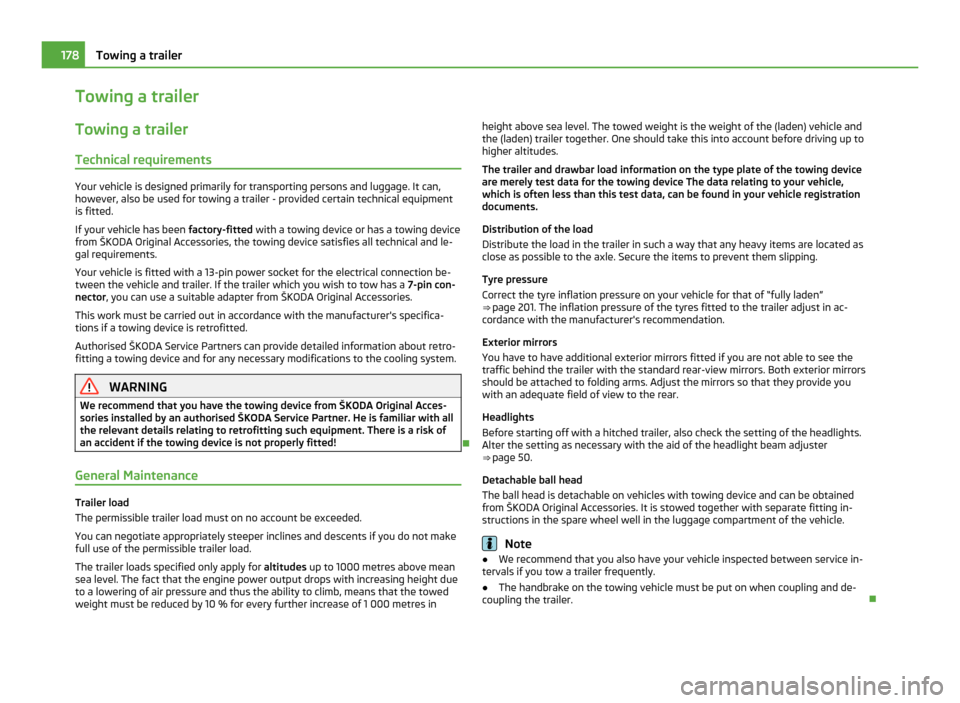
Towing a trailer
Towing a trailer
Technical requirements Your vehicle is designed primarily for transporting persons and luggage. It can,
however, also be used for towing a trailer - provided certain technical equipment
is fitted.
If your vehicle has been
factory-fitted with a towing device or has a towing device
from
ŠKODA Original Accessories, the towing device satisfies all technical and le-
gal requirements.
Your vehicle is fitted with a 13-pin power socket for the electrical connection be-
tween the vehicle and trailer. If the trailer which you wish to tow has a 7-pin con-
nector , you can use a suitable adapter from ŠKODA Original Accessories.
This work must be carried out in accordance with the manufacturer's specifica-
tions if a towing device is retrofitted.
Authorised ŠKODA Service Partners can provide detailed information about retro-
fitting a towing device and for any necessary modifications to the cooling system. WARNING
We recommend that you have the towing device from ŠKODA Original Acces-
sories installed by an authorised
ŠKODA Service Partner. He is familiar with all
the relevant details relating to retrofitting such equipment. There is a risk of
an accident if the towing device is not properly fitted!
General Maintenance Trailer load
The permissible trailer load must on no account be exceeded.
You can negotiate appropriately steeper inclines and descents if you do not make
full use of the permissible trailer load.
The trailer loads specified only apply for
altitudes up to 1000 metres above mean
sea level. The fact that the engine power output drops with increasing height due
to a lowering of air pressure and thus the ability to climb, means that the towed
weight must be reduced by 10 % for every further increase of 1 000 metres in height above sea level. The towed weight is the weight of the (laden) vehicle and
the (laden) trailer together. One should take this into account before driving up to
higher altitudes.
The trailer and drawbar load information on the type plate of the towing device
are merely test data for the towing device The data relating to your vehicle,
which is often less than this test data, can be found in your vehicle registration
documents.
Distribution of the load
Distribute the load in the trailer in such a way that any heavy items are located as
close as possible to the axle. Secure the items to prevent them slipping.
Tyre pressure
Correct the tyre inflation pressure on your vehicle for that of
“fully laden”
⇒ page 201. The inflation pressure of the tyres fitted to the trailer adjust in ac-
cordance with the manufacturer's recommendation.
Exterior mirrors
You have to have additional exterior mirrors fitted if you are not able to see the
traffic behind the trailer with the standard rear-view mirrors. Both exterior mirrors
should be attached to folding arms. Adjust the mirrors so that they provide you
with an adequate field of view to the rear.
Headlights
Before starting off with a hitched trailer, also check the setting of the headlights.
Alter the setting as necessary with the aid of the headlight beam adjuster
⇒ page 50.
Detachable ball head
The ball head is detachable on vehicles with towing device and can be obtained
from ŠKODA Original Accessories. It is stowed together with separate fitting in-
structions in the spare wheel well in the luggage compartment of the vehicle. Note
● We recommend that you also have your vehicle inspected between service in-
tervals if you tow a trailer frequently.
● The handbrake on the towing vehicle must be put on when coupling and de-
coupling the trailer. 178
Towing a trailer
Page 181 of 252
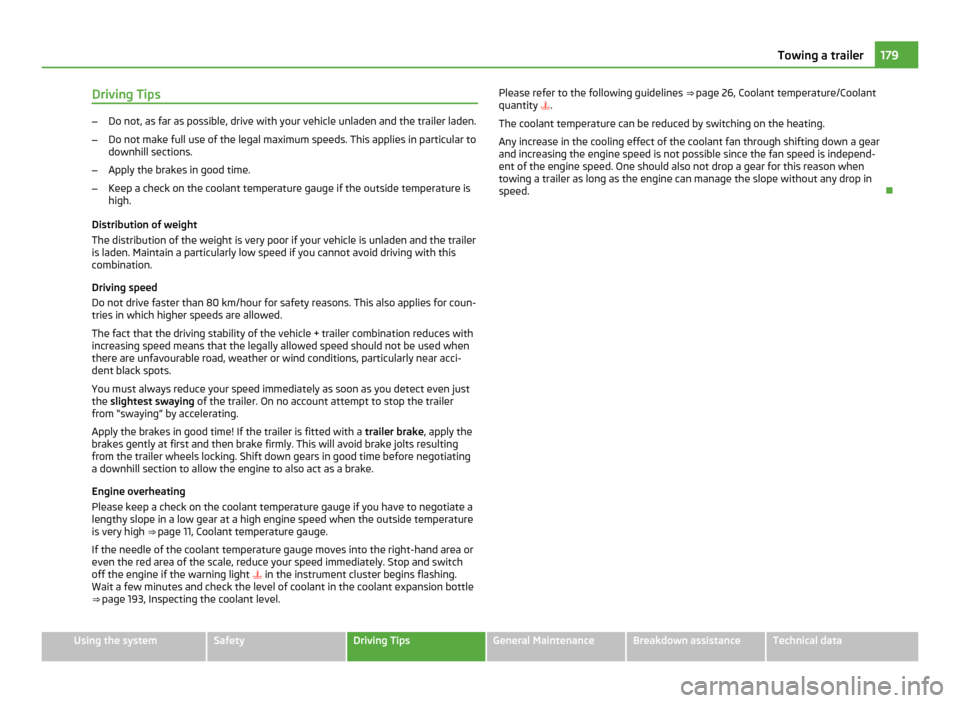
Driving Tips
–
Do not, as far as possible, drive with your vehicle unladen and the trailer laden.
– Do not make full use of the legal maximum speeds. This applies in particular to
downhill sections.
– Apply the brakes in good time.
– Keep a check on the coolant temperature gauge if the outside temperature is
high.
Distribution of weight
The distribution of the weight is very poor if your vehicle is unladen and the trailer
is laden. Maintain a particularly low speed if you cannot avoid driving with this
combination.
Driving speed
Do not drive faster than 80 km/hour for safety reasons. This also applies for coun-
tries in which higher speeds are allowed.
The fact that the driving stability of the vehicle + trailer combination reduces with
increasing speed means that the legally allowed speed should not be used when
there are unfavourable road, weather or wind conditions, particularly near acci-
dent black spots.
You must always reduce your speed immediately as soon as you detect even just
the slightest swaying of the trailer. On no account attempt to stop the trailer
from “swaying” by accelerating.
Apply the brakes in good time! If the trailer is fitted with a trailer brake, apply the
brakes gently at first and then brake firmly. This will avoid brake jolts resulting
from the trailer wheels locking. Shift down gears in good time before negotiating
a downhill section to allow the engine to also act as a brake.
Engine overheating
Please keep a check on the coolant temperature gauge if you have to negotiate a
lengthy slope in a low gear at a high engine speed when the outside temperature
is very high ⇒ page 11, Coolant temperature gauge
.
If the needle of the coolant temperature gauge moves into the right-hand area or
even the red area of the scale, reduce your speed immediately. Stop and switch
off the engine if the warning light in the instrument cluster begins flashing.
Wait a few minutes and check the level of coolant in the coolant expansion bottle
⇒ page 193, Inspecting the coolant level. Please refer to the following guidelines
⇒
page 26, Coolant temperature/Coolant
quantity .
The coolant temperature can be reduced by switching on the heating.
Any increase in the cooling effect of the coolant fan through shifting down a gear
and increasing the engine speed is not possible since the fan speed is independ-
ent of the engine speed. One should also not drop a gear for this reason when
towing a trailer as long as the engine can manage the slope without any drop in
speed. 179
Towing a trailer Using the system Safety Driving Tips General Maintenance Breakdown assistance Technical data